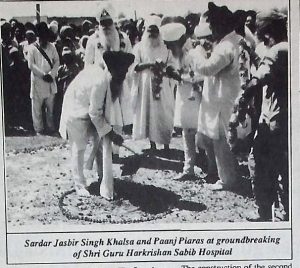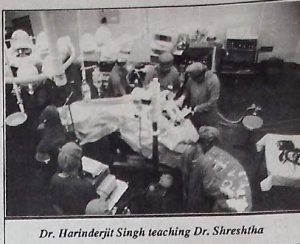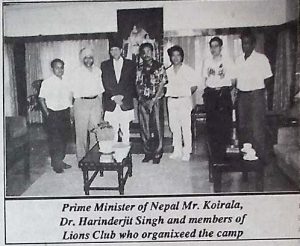


By Dr. Harinderjit Singh “Salvation, Worldly comforts, and life’s department are obtained through thine service, which thou thyself makes Man perform.” Guru Granth Sahib, Page 749. Sewa (service) is an important part of Sikhism and can be in any form. Being an ophthalmologist, I could see the tremendous need for timely treatment of the multiple curable and preventable eye diseases of the less privileged in the third world countries. Keeping this in mind, and with the much appreciated assistance of the Association of Sikh Professionals in United States of America (a very noble organization in U.S.A.), was able to conduct an Eye Camping Punjab, India and in Kathmandu, Nepal. The project was sponsored in U.S.A. by the Association of Sikh Professionals and locally in Punjab by Gunu Granth Sahib Society and Gurdwara Sahib of Sector 34, Chandigarh. In Nepal the project Was sponsored by the Lions Club of Kantipur.
The first eye camp was held in Kathmandu, Nepal in August of 1993. The goal of this full six day eye camp was to perform surgery and lasers on prescreened patients with complicated vitreoretinal diseases. The Lions Club of Kantipur working closely with the ophthalmologists and authorities of Tribhuyan Hospital to make the arrangements for using the Operating Room facility at the hospital: About five hundred patients were screened by the ophthalmologists at the teaching hospital of Tribhuvan which is the only teaching hospital in the area. Of the five hundred patients, one hundred patients were diagnosed to have retinal problems and these patients were evaluated by meat the camp. Twenty to twenty-five of these paticnis were found to have severe vilreoretinal problems reining complex microscopic procedures. All the equipment and medical supplies were donated by the Association of Sikh Professionals of USA. They were installed over a two day period at the Tribhuvan Hospital by their engineering staff. Simultaneously during these two. days the one hundred patients were screened by me. On the third day surgery was begun and over the next four days as many surgeries as possible were performed, The cases performed had the following vitreoretinal diseases:
- Vitreous hemorrhages from trauma 2.Proliferative diabetic retinopathy with vitreous hemorrhage
- Eales’ disease with vitreous hemorrhage 4, Retinal detachment with prolife ergative vilreoretinopathy 5. Traction retinal detachment from other causes All of these patients were followed up postoperatively and the results of the surgeries were good. As the camp was very successful, i, was decided by those involved that a similar camp should ‘be held annually. Ophthalmologists from U S.A. are welcome to participate in the future eye camps. The next camp is planned for December of 1994. A two day free medical camp was held on August 1415, 1993 with the help of Guru Granth Sahib Society and Gurdwara Sahib of Sector 34, Chandigarh in Punjab, Thiswasheld at Gurdwara Sahib of Sector 34, Chandigarh. This ‘camp was not limited to eye diseases but included Internal medicine, Pediatrics, Ayurvedic medicine, Homeopathic medicine, etc, Three local ophthalmologists worked with meat the camp and together we saw 500 eye patients over two days. Of these, Fifteen eyes required laser surgery and this was done right there with a laser taken from the U.S.A. with the help of the Association of Sikh Professionals. A few patients required surgery for complex vitreoretinal problems but due to a lack of appropriate instruments, facilities, ctc., surgery could not be done. Besides the laser, the other instruments donated by the Association of Sikh Professionals were the Bscan and diathermy unit.
Several discussions were held with Bhai Jasbir Singh Khalsa and it was decided to build a State of the Art eye hospital to provide eye care to the needy in Punjab. With this in mind a charitable trust named Guru Harkrishan Sahib Charitable Eye Hospital was formed. The goals of the charitable eye hospital are as follows? 1. Have the latest state of the art technology to treat all ocular diseases. 2. Provide subspecialty service in diseases of the come a, cataracts, glaucoma, plastic surgery, orbital diseases retinal and vitreous surgery, and oncology.
3, Have a facility for an eye bank, ophthalmic library, pharmacy, and optical center. 4,Provide and have facilities available for research by ophthalmologists in the institution.
- To have training programs and workshops and to share knowledge in ophthalmology with the test of India and with other countries.
6.Tohaveexchange programs with medical students of ophthalmology between the U.S.A. and this institute.
7.10 have a residency program in ophthalmology.
8,To have a training program for ophthalmology technicians.
For construction of this hospital two acres of land was bought in Sohana right across the Akal Ashram Gurdwara. Sohana is about 4 kilometers from Mohali and eight to ten kilometers from Chandigarh. The hospital is being built in two phases. The first phase has begun and is expected to be complete in September or October of 1994. The first phase will be a general ophthalmology clinic and will include two exam rooms, a Jaser room, an O.R. room, an eye Jab, and awaiting room. This phase is expected to be operational by December31stof 1994. This space is planned such that later when the second phase is completed it can be used for guest house facility. The second phase is the construction of the actual hospital. It is going to be a 40,000 to 50,000 square foot area and architects are working on its design as per the specifications of the hospitals in U.S.A. The ground breaking ceremony for phase one was held on March27, 1994 by the Punj Pyaras. Professor Manjit Singh, the Jathedar of Akal Takht, presided over the function. ‘The construction of the second phase will begin in 1995 and will be completed in two years. An ophthalmologist will be employed to run the clinic. Another ophthalmologist has been sent to Sankara Nethralaya, Madras to have advanced vitreoretinal fellowship training and will join the clinic after completing his training. With the kind donations of Sewadars in U.S.A. and other countries, this hospital will become a State of the Ant eye institution in Punjab, India. Donations may be in the form of money, supplies, equipment, etc. For further information, contact: Dr. Harinderjit Singh, 3685 Wheeler Road Ste.#201, Augusta, GA 30909, Ph.#t: (706) 6500061; or: Dr. Gurpal S. Bhullar, Secretary of the A.S.P., P.O. Box 140, Hopewell, VA 23860, Ph.#: (804) ‘5419290.
Article extracted from this publication >> September 30, 1994